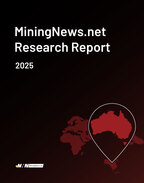This article is 12 years old. Images might not display.
The company plans to raise $A3-5 million through its float on the Australian Securities Exchange, and generate $3.5-12 million from gold production in the 12 months from June.
At an investor presentation on Tuesday at Perth’s elegant Celtic Club, managing director and chief executive Bob McNeil emphasised Torque was not a grassroots venture and developments would be quick.
He said a small quarry penetrating just 20-25m of Torque’s flagship Moina project in the state’s north would be underway this year with no overburden, environmental or Aaboriginal heritage setbacks expected.
“It’s right at the surface,” he said of the relatively unexplored goldfield. “From the first cut, it will go to the mill.”
But Torque’s accelerated schedule has been attributed to more than just shallow targets, tantalising outcrops at historical pits and minimal permitting headaches.
Frontier has invested some $9 million dollars in exploration work at its Tasmanian assets since 2002. Since Torque’s parent company has completed preliminary geophysics and geochemistry work at Moina, the upstart explorer will debut in an advanced, development stage.
So far, indicated resources at Moina total 313,000 tonnes at 2.49gpt gold plus credits in bismuth, lead, zinc and silver. Contained metal is 25,058 ounces gold, 125,811oz silver, 256t bismuth, 2311t lead and 1953t zinc.
McNeil also touted Torque’s advances in exploration techniques, not available to previous explorers. Through a combination of high-tech methods, the company has been able to speed up progress, despite an inhibiting blanket of basalt several metres thick on the surrounding geology.
Induced polarisation geophysics (3DIP) programs, aeromagnetics and short-wave infrared sampling measures have sketched some basic mineralisation trends at Moina and related projects to Tasmania’s west coast. Funding from the IPO is expected to further pinpoint targets in the coming months through the mobilisation of two additional drill rigs.
Frontier has already completed 134 drill holes totalling 6144m, extensive geochemical sampling, a large-scale 3DIP survey, a helicopter-borne aeromagnetic, and a review of earlier electromagnetic and geochemical data collected by previous explorers.
Drill highlights have included a 13m intersection grading 44.1gpt gold and a 25.4m sample grading 4.33gpt gold.
Moina’s Stormont area is the primary gold target and holds about a third of the company’s resource. Mineral Resources Tasmania published a bulletin saying that the granite believed to be the source of gold mineralisation at Stormont contained five times more gold than average granite.
On the southwest coast, the Southern Mt Read Volcanics (SMRV) project is purported to have massive sulphide deposits and many geological similarities to the region’s ‘holy host’ horizon pursued by gold explorers elsewhere in the Mt Read Volcanic.
Along strike from SMRV’s promising Wart Hill section, extensive gold in streams and soil anomalism have led to the discovery of the Sassy Creek where one 3m intersection recorded 17.5gpt gold.
Torque said it had discovered a large system of sulphide centres and assimilated sulphide halos from 75m-300m in depth at the Mt Read area.
The plan is to station at least one rig in the region to drill some wildcat holes and clarify the nature of the formations while more concentrated developmental work progresses at Moina.
One point of contention with Frontier shareholders wary of embracing the new Tasmania-focused developer has been the scheduling of the IPO.
Torque has decided to launch the IPO before finalisation of the feasibility study and the publishing of results from the 14 holes the company has recently drilled but not assayed
The move has caused some investors to feel left in the dark and sceptical of Torque’s motives, or as one attendant at the Perth presentation put it, “it’s as though you were dangling some sort of carrot in front of our noses.”
McNeil responded that launching the IPO before releasing the latest exploration results was a deliberate strategy to keep the share price up near the listing price in the first volatile months of Torque’s ASX float.
“We felt that releasing them over the last few months would have no impact at all on the Frontier share price and no impact at all on the prospectus for Torque, because there’re numerous other results there of a similar calibre,” McNeil said.
“What we need is something to support the IPO after listing.
“The idea is to give the IPO some basis in those first months,” he continued
“With most IPOs when you raise money, the company starts work and it’s two or three or four months before you get any results
“This is always a bad time when the share price will decrease and there’s nothing that can be done.”

























